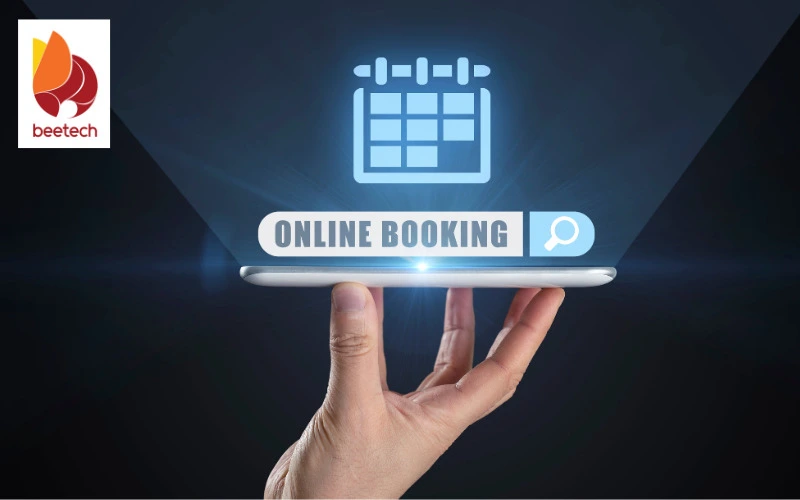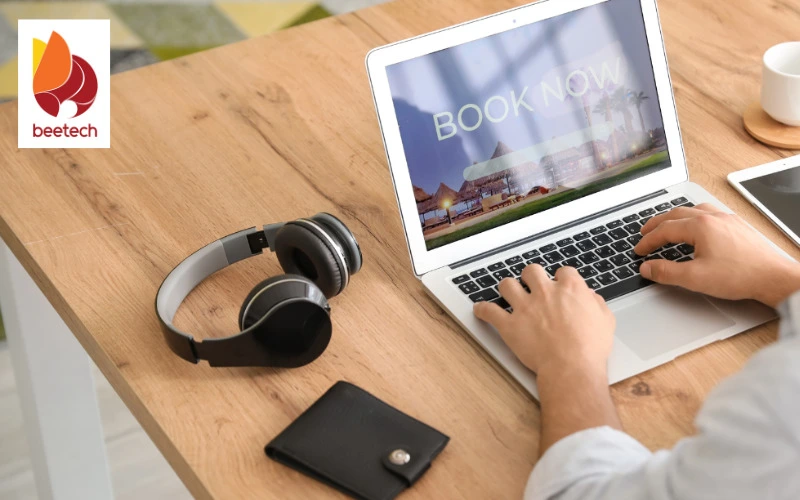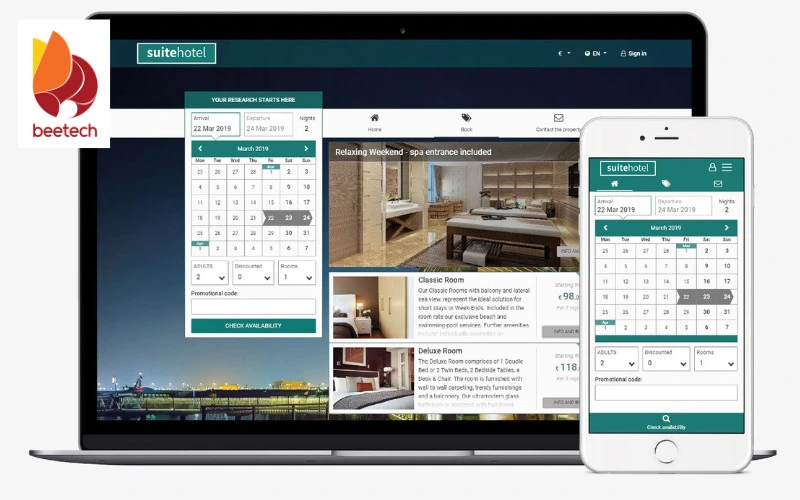What do business need to do to develop a tour booking website?
Nowadays, customers prefer booking tours online rather than visiting travel agencies in person. With just a few clicks on their phones or computers, they can easily search, compare, and book tours in no time. For businesses, developing a tour booking website not only expands their market reach but also optimizes revenue and enhances customer experience. A well-designed website builds trust and attracts more bookings. So, how can you create an effective tour booking website? Let’s find out!

1. Why should businesses develop a tour booking website?
The travel industry is evolving rapidly with the advancement of technology. Today, customers no longer visit travel agencies in person to book a tour. Instead, they search for information and make reservations online. Therefore, developing a tour booking website is essential for businesses to keep up with trends and maximize revenue.
1.1. Changing customer booking habits
Currently, more than 80% of travelers search for and book tours through websites before making a final decision. Instead of spending time visiting travel agencies, they browse the internet, compare prices, read reviews, and book instantly when they find a suitable option.
Moreover, the “Mobile-first” trend is booming. Most customers use their smartphones to search for tours rather than desktops. If a business does not have a mobile-friendly tour booking website, it could risk losing a significant number of potential customers.
1.2. Increasing revenue and expanding market reach
One of the biggest advantages of developing a tour booking website is that it allows businesses to reach customers 24/7, regardless of location.
if a business relies solely on in-person bookings, it is limited by office hours and geography.
in contrast, a tour booking website operates continuously, enabling customers to browse, book, and pay anytime—even late at night or on holidays.
as a result, businesses can increase revenue due to their market expansion to distant customers and international travelers.
Additionally, a well-designed website helps reduce operational costs. Businesses no longer need extensive customer support teams, as all essential information about tours, pricing, and itineraries is displayed online, allowing customers to find what they need independently.
1.3. Enhancing brand image and professionalism
A business with a well-structured website creates a professional first impression for potential customers.
A website that clearly provides information about the company, its services, visuals, and customer reviews builds trust and encourages bookings.
furthermore, developing a tour booking website strengthens brand recognition. When customers search on Google and find your website ranking high, it establishes your business as a reputable player in the travel industry.

2. What do businesses need to do to develop a tour booking website?
Developing a tour booking website is a crucial step for travel businesses to expand their market and increase sales. However, to create an effective website, businesses need to prepare carefully, from defining target customers, choosing a platform, designing the interface optimizing SEO, and promoting the brand. Here are the necessary steps to develop a professional tour booking website.
>>> Read more: Things to note develop e-commerce website
2.1. Define goals and target audience
Before developing a tour booking website, businesses need to clearly define their target audience to design the interface, content and features accordingly. Some important questions to ask include:
Is the website aimed at domestic or international customers?
If targeting international customers, the website should have multiple languages and support international payment methods such as PayPal, Visa, Mastercard, etc.
Which customer segment are you targeting?
Low-budget tours: Aimed at budget-conscious customers, students, and young travelers. The website should have a simple design to keep operating costs low.
Premium tours: Targeting high-income customers, the website should have a luxurious interface, high-quality images, and a smooth booking experience.
Experiential tourism: Aimed at those who love exploration, the website should offer detailed itineraries, realistic photos, and reviews from past customers.
Leisure tourism: For those seeking relaxation at resorts and hotels, the website should offer combo services (tour + accommodation + flight tickets).
Defining the target audience helps businesses build a tour booking website that resonates with users and increases conversion rates.
2.2. Choose the right platform
Choosing the right platform is crucial when developing a tour booking website. There are three common solutions available today:
Custom-coded website
Pros: Flexible, highly secure, can be developed according to specific needs.
Cons: Expensive, long development time, requires technical expertise to manage.
Suitable for: Large businesses that need a custom tour booking system with integrated APIs.
WordPress website + booking plugins
Pros: Easy to use, low cost, many plugins support tour booking like WP Travel, Tour Master, etc.
Cons: Limited customization, lower security than custom-coded websites.
Suitable for: Small to medium businesses wanting to develop a tour booking website quickly.
SaaS platforms like Travelopro, Trawex
Pros: Pre-integrated tour management, payment systems, booking management.
Cons: Limited customization, and ongoing subscription costs.
Suitable for: Startups that need to launch a website quickly without heavy customization.
The choice of platform depends on the business's budget, development needs, and management capabilities.

2.3. Design a user-friendly interface with optimized UX/UI
The website interface is a crucial factor that impacts user experience. When developing a tour booking website, focus on:
Simple, easy-to-use design: Clear layout, easy navigation for finding tour information.
Smart search filters: Allow customers to search for tours by location, price, type of travel, etc.
Responsive design: Ensure the website looks great on all devices (desktop, mobile, tablet).
Attractive images and videos: Help customers visualize the tour and encourage bookings.
A user-friendly website improves conversion rates and keeps customers engaged.
>>> Read more: Application software offshore development process
2.4. Integrate online booking features
To build an effective operational website, you need to integrate essential booking features like:
Smart booking system: Allows customers to choose the date, number of people, and pickup/drop-off points.
Online payment: Supports various payment methods such as credit cards, e-wallets (Momo, ZaloPay), and bank transfers.
Chatbot & customer support: Integrate AI chatbots or live chat for quick customer assistance.
These features make the booking process easier and enhance customer experience.
2.5. Optimize SEO to rank higher on Google
SEO (search engine optimization) helps the website reach more customers. When developing a tour booking website, focus on optimizing:
On-page SEO:
Optimize titles, and meta descriptions with keywords.
Optimize images, and use alt text to help Google identify content.
Improve page load speed to reduce bounce rates.
Off-page SEO:
Build backlinks from reputable websites, and travel forums.
Promote the website on social media, Google My Business.
Content SEO:
Write blogs sharing travel tips, and tour booking guides.
Create engaging content to keep visitors on the site longer.
Good SEO practices help the website rank higher in search results, increasing organic traffic without excessive advertising costs.
2.6. Ensure fast loading speed and good security
A slow website will drive customers away immediately. To improve speed and security, businesses should:
Optimize images: Use WebP format, and compress images to load faster.
Use a CDN (content delivery network): Helps improve load times regardless of the customer's location.
Install SSL certificates: Ensure the website is secure and customer data is protected during transactions.
A fast, secure website enhances trust and improves conversion rates.
2.7. Marketing strategy & website promotion
Once the tour booking website is developed, businesses need to promote it to attract customers:
Run Google Ads, and Facebook Ads: Helps quickly reach potential customers.
Email marketing: Send promotional emails about tours, special offers, and customer care.
Social media marketing: Post on Facebook, Instagram, and TikTok to create viral effects.
Combining multiple marketing channels helps increase website traffic and bookings.
3. Common mistakes to avoid when developing a tour booking website
Developing a tour booking website helps businesses expand their market and increase revenue. However, if not done correctly, the website may not be as effective as expected. Below are common mistakes to avoid.
3.1.Cluttered and difficult-to-use interface
A website that is too complicated, overly colorful, or poorly structured can frustrate visitors and make them leave immediately. To ensure a user-friendly experience, businesses should:
Design a clean, intuitive interface that works well on both desktop and mobile.
Organize content clearly, making it easy for users to find tour information.
Place booking buttons, contact options, and chat support in visible locations.
3.2. Lack of SEO optimization – Difficult to rank on Google
A well-designed website is useless if it doesn’t appear on search engines. Some common SEO mistakes include:
Failing to optimize titles, descriptions, and content.
Using high-resolution images without compression, slowing down the site.
Lacking high-quality content, such as travel blogs, tour reviews, and travel guides.
Investing in SEO from the start ensures higher rankings on Google and better visibility for potential customers.
3.3. Slow page load speed – Reducing conversion rates
If a website takes more than three seconds to load, users are likely to leave and look elsewhere. Common causes of slow loading speeds include:
Unoptimized images and videos.
Weak hosting servers are unable to handle high traffic.
Too many unnecessary plugins or complex code.
To improve speed, businesses should use high-quality hosting, optimize images, and implement caching techniques.
Conclusion
Developing a tour booking website not only helps businesses expand their reach but also enhances customer experience. To succeed, companies must avoid common mistakes such as a cluttered interface, poor SEO, and slow loading speeds... If you are looking for a professional solution to develop a tour booking website, contact BeetechSoft today for a free consultation.
